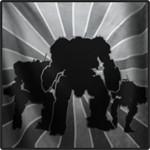 SmokedJag, on 14 February 2017 - 03:58 PM, said:
SmokedJag, on 14 February 2017 - 03:58 PM, said:
Well, to addres it from a physics perspective...
Issues with Large 'Mechs
-- Joints need to be unobstructed to work, meaning they are very difficult to armor. Even if you put a housing over them, it can't be as thick as tank glacis armor. A joint kill of a walker, especially a heavy mass one, will mobility kill it at least as surely as it mobility kills a human. Tanks can be mobility killed as well but the tracks are comparatively difficult to hit and there are only two of them.
-- Center of gravity. Humans have a lot of weight in their legsand butt, such that our center of gravity is around our sacral vertebrae. Attempts at making freestanding walkers inevitably wind up having to load weight into the legs in a broadly pyramid fashion. If your center of gravity is too high you will just fall over; the neural helmet doesn't help here because humans again have a much LOWER center of gravity than you might think. And people with massively overdeveloped upper bodies (don't skip leg day!) or obese guts do have problems with balance and can't move very well. Most BattleMech designs are grossly top-heavy with no consideration of balance.
-- Square-cube law. BattleMech masses are arbitrary and not connected to the art drawings. Mass bloats rapidly with increased physical dimensions, even if you aren't loading new heavy equipment and support structures, which heavy and assault 'Mechs do. The weaponry anyway; internal structure is abstracted as a ratio with hitpoints without concern for stuff like putting 35+ tons of weapons above the waist or 15 ton weapons in lower, non-offset arms. Bigger 'Mechs will also have thinner armor because their surface area is much, much larger. I'm not sure how much more protected surface area a Thor has than a Locust but "order of magnitude" comes to mind. Four times as much armor isn't going to come close to making the same thickness skin, meaning that the heavy 'Mech is at least as easy to kill as the light 'Mech.
The upshot of all of this is that a Heavy or Assault 'Mech would have to be far heavier than its BT weight classes (again with that nasty offsetting leg weight as well) which will in turn impact its ground pressure and its energy demands to move.
-- Physical room i.e. the space in our universe that the dimensions of the matter of shells/missiles physically occupy. Virtually none of the BattleTech designs have enough room in their chassis to store realistic quantities of munitions and none of them hard follow rules regarding getting the ammo automatically from the magazine to the weapon. BattleTech also cheats here by having surface magazines (missiles) that are not armored and cannot be armored not explode when hit, including when hit by energy weapons that would handily detonate solid rocket fuel.
-- Perpendicular instead of parallel/lateral armor faces. There's a reason armor slope was refined for AFVs and something that looks like a humanoid is stuck with large vertical surfaces that cannot take advantage of it.
1 - Tracks are ridiculously easy to hit, even from the front of the tank. All you have to do is cause even the slightest amount of damage to the track linkages or drive sprockets to completely f**k a track. Hell, it doesn't even take enemy fire to throw a track. Slip in to a ditch? Thrown track. Turned to hard? Thrown track. Tried to turn while going fast? Probably threw your track and flipped. Simply put, something as basic as a HMG can destroy a tank track, let alone something like an autocannon or grenade.
2 - Fair point. Rule of Cool trumped actual design considerations when BT art was drawn. Doesn't mean a walker can't be built, but it does mean it'd need a design closer to that of the WH40k Warhound Titan; where the torso is basically a squat box with the weapons hanging around waist level.
3 - Armor is irrelevant on a modern battlefield. Any actual protection an armored vehicle has anymore comes from Active Protection Systems (APS) or layered multi-purpose ERA, such as Malachit or Relikt. Tandem/Triple charge HEAT munitions have rendered even the vaunted composite armors of western MBT's effectively useless... Though the rise in practically mass-manufacturable nanoalloys and nanoceramics has given armor technology a shot in the arse, as it were. Still not enough to overcome the massive disparity between weapons tech and "hard" armors. Until the next armor breakthrough comes around, armored vehicles are basically going to revert to a "post-HEAT" state, where armor was useless against anything but small arms and autocannons, and speed/agility/maneuverability were king.
Also, as for AP impacts, even the newest MBT's are only designed to take frontal armor hits from APFSDS and the like. The sides and rear have to be protected by single layer ERA skirts, since doubling up side/rear ERA isn't currently possible without making the vehicle obscenely wide.
4 - Another fair point, the fitting rules would be far more interesting if you had designated loading bin crit slots (and thus limited total ammo space) to feed weapons... Though if we did that, the weapon systems themselves would need radical changes. Everything except lasers would get lighter by several tons, Missiles would be amazing, Ballistics would be insanely powerful for their weight, and Energy weapons would really only be worthwhile by virtue of not needing ammo... Though the PPC and its variants would be quite dangerous exceptions to that rule. I guess Plasma Rifles wouldn't be too bad either, insane mech-vaporizing firepower at the cost of practically zero range... Although IIRC there's a way to cause plasma clouds to create their own magnetic field, so with sufficient acceleration even a few microseconds of magnetic stabilization could give you a few dozen meters extra range.
5 - Non-humanoid master race. Also, refer to #3.
 Snowbluff, on 14 February 2017 - 08:07 PM, said:
Snowbluff, on 14 February 2017 - 08:07 PM, said:
I agree entirely. Locust with an AMS to stop the small antitank missiles is more sensible than using 100 ton mechs like modern armor.
People don't think forward very well. It wasn't until the F22 that stealth fighters made any sense. Tactics for mechs would have to be developed as they are.
Do you even history? The idea, or rather dream, of stealth aircraft has existed since the first early-warning radar system was built. As it happens, it was K r a u t Space Magic that almost made it a reality in late 45', though more by accident than anything else.
EDIT: Seriously, the censor is just ridiculous.
Edited by Alek Ituin, 14 February 2017 - 10:26 PM.
 razenWing, on 14 February 2017 - 02:46 PM, said:
razenWing, on 14 February 2017 - 02:46 PM, said:


































